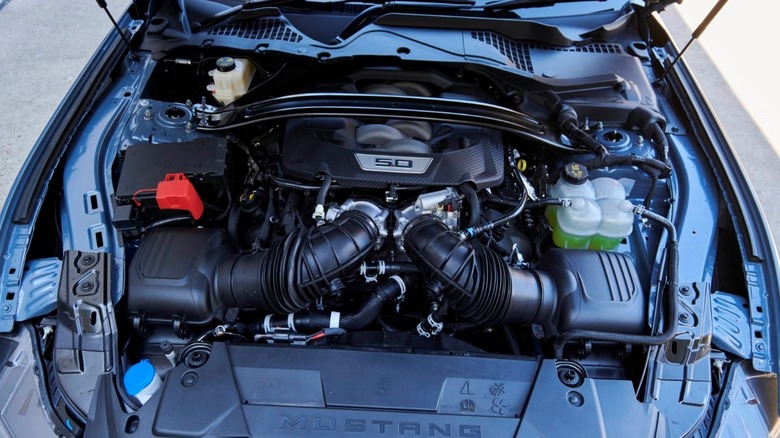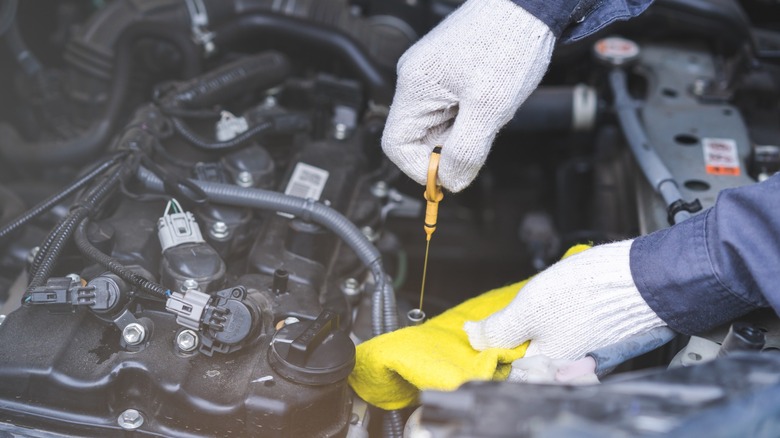Common Problems With The Ford 5.0 Coyote Engine (According To Owners)
Ford developed the 5.0-liter Coyote, destined to become known as one of the best V8 engines ever made, specifically for the Mustang GT. With dual overhead cams, Twin independent Variable Cam Timing (TiVCT), and four valves per cylinder, the first-gen Ford 5.0 Coyote in the 2011 Mustang GT produced 412 horsepower and 390 pound-feet (lb-ft) of torque.
Ford F-150 enthusiasts often argue that 2015 through 2017 were the best years for Ford's Coyote engine. That second-generation version produced a respectable 435 horsepower and an even 400 lb-ft of torque. Ford's Gen 3 Coyote improved on the Gen 2 version by ramping up the engine's power output to 460 horsepower and 420 lb-ft of torque from 2018 through 2023.
The third-gen 5.0 Coyote added a direct fuel injection system to the existing port injection system found on previous Coyote iterations. In addition, cylinder diameters increased from 92.2mm to 93mm to accommodate larger pistons, and an the compression ratio was boosted from 11.1:1 to 12.1:1.
The 2024 Ford Mustang Dark Horse welcomed the fourth-gen 5.0 Coyote V8, which boasted 500 hp and 418 lb-ft of torque, making it "the most powerful non-Shelby [Mustang] edition ever," according to Ford. With the relative lack of data for the Gen 4 Coyote, many feel the previous generation is the best Coyote engine. However, Ford 5.0 Coyote owners from every generation experience some common problems.
Excessive oil consumption
One predominant problem reported by Ford 5.0 Coyote engine owners is excessive oil consumption. Ford's Technical Service Bulletin (TSB) 19-2365 says "some 2018-2020 F-150 vehicles equipped with a 5.0-liter engine may exhibit excessive oil consumption of greater than 1L (1 quart) in 4,800 km (3,000 mi) with no visible oil leaks." Ford states the issue results when oil is sucked into the combustion chambers by "high intake manifold vacuum during some deceleration fuel shut off (DFSO) events." There's a class action lawsuit in U.S district court centered around 2018 to 2020 5.0 Coyote-powered Ford F-150 pickups.
The lawsuit, Lyman v. Ford, claims the issue is caused by defective pistons and piston ring assemblies allowing crankcase oil into the combustion chambers. Ford's remedy for the oil consumption issue as outlined by the TSB is to "reprogram the powertrain control module (PCM), install a new engine oil level indicator and change the engine oil and oil filter." The new PCM calibration should reduce the amount of oil being pulled into the combustion chambers. There are plenty of posts from owners about this on the r/F150 subreddit, including one from u/CuttingEdgeRetro that claims they burn three quarts of oil every 3,000 miles. Other owners posted to F150 Forum reporting similar consumption as well as frustration with Ford's response to the problem.
Less common Ford 5.0 Coyote owner-reported problems
First-gen Ford 5.0 Coyote owners occasionally report issues with failed connecting rod bearings. This condition typically results in an audible engine noise best described as a "tick." However, posters to the r/S550Mustang subreddit are quick to point out that the Coyote's direct-injection fuel system also produces ticking sounds that — while normal — may be confused with more problematic conditions. Many owners accept this as "Coyote tick" and simply turn up the stereo. Another serious, though relatively rare, owner complaint involving the 5.0-liter Coyote is head gasket failure. This can cause the oil and coolant to get mixed together, compromising the effectiveness of both. This issue is primarily related to first- and second-gen Ford Coyote engines.
In a post on the Mustang Ecoboost forum, several Coyote owners reported this issue and recommended pushing Ford for a complete engine replacement if the gasket fails. Ford Coyote engines can also suffer from dirty throttle body and mass airflow sensor assemblies. While these issues can affect the performance of the engine, cleaning these components is relatively simple. In fact, you can easily clean your engine's throttle body without removing it. Misfires caused by faulty spark plugs and ignition coils are another cause for concern reported by 5.0-liter Coyote engine owners. However, given the engine's high-performance nature, the extra maintenance shouldn't come as a surprise. Fortunately, changing spark plugs and servicing ignition coils falls under the list of DIY engine maintenance tasks you can do at home if you're so inclined.


